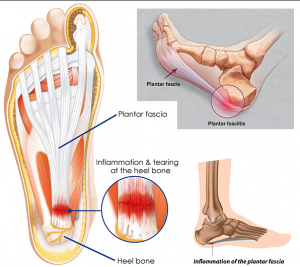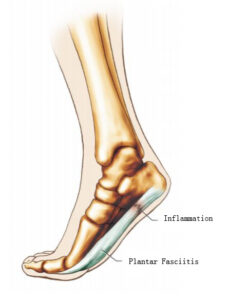A 17-year-old high school track and field athlete should be on the track and field at this time, actively preparing for the upcoming competition, but he walked into the rehabilitation clinic with a sad face, limp, and said in a sad voice: Doctor, Recently, I strengthened the training intensity for the upcoming competition. As a result, the part of the sole started to hurt in the past two days, especially the moment I sat for a long time and stood up, the pain was so painful that my tears burst out, which also seriously affected the training. And game performance.
Another housewife in her 40s also suffered from foot pain, especially when she got up in the morning and stepped on the ground, she was so painful that she could hardly walk, which caused a lot of housework delays. Her husband also misunderstood that she was lazy and not doing housework, not only physical suffering. My heart is more bitter.
The two patients are of different age groups and daily life patterns, but they have the same problem-plantar fasciitis (plantar fasciitis).
What is the plantar fascia?
As the name suggests, it is a layer of fascial tissue located on the sole. It starts from the heel and extends in a fan shape to the 5 toes. The function is to provide tension on the heel when we walk or run.

Causes of plantar fascia inflammation
Usually, it is caused by minor damage to the plantar fascia without consciously. After a long time of accumulation and overuse, it produces inflammatory symptoms, which is the so-called “plantar fasciitis.” If there are congenital foot abnormalities, such as flat feet or high arch feet, and the athlete’s training intensity changes suddenly, plantar fasciitis is also more likely to occur.
Symptoms of plantar fasciitis
The most common symptom is a pain in the inner part of the heel, especially the moment when you get up in the morning and step on the ground, or the moment when you suddenly stand up and step on the ground after sitting for a long time, the pain will slowly decrease afterward, but there is still a dull pain feel.
In addition, sole pain, in addition to plantar fasciitis, there are many other common symptoms, such as small bumps that grow from the plantar fascia, called “Plantar fibroma”; Painful “metatarsalgia” and so on require a differential diagnosis. Therefore, if there are symptoms of foot pain, it is recommended to go to a medical institution for evaluation and not to buy medicine by yourself.
Diagnosis of plantar fasciitis
In addition to clinical symptoms and physical examinations, fast, non-invasive ultrasound examinations can also be used. Under ultrasound examination images, the inflamed plantar fascia may appear to be swollen, and there may also be increased blood flow. Help doctors quickly make a diagnosis. To rule out other potential fractures or bone diseases, X-rays will be performed.
Treatment of plantar fasciitis
1. Medication: You can use anti-inflammatory drugs or ointments, combined with hot compresses at home to achieve a curative effect. If hot compresses in the acute phase may cause pain to worsen, ice compress is recommended in the acute phase.
2. Sports rehabilitation treatment: You can go to the rehabilitation department of a medical institution for treatment. In terms of equipment, therapeutic ultrasound and electrotherapy can be used to reduce inflammation and pain, and cooperate with plantar fascia stretching exercises and muscle strengthening exercises to achieve therapeutic effects.

In addition, custom-made insoles or tapes can also improve plantar fasciitis.
3. Injection therapy: Traditionally, steroid injections are used to treat plantar fasciitis, but recently there is a newer injection therapy—hyperplasia therapy. The principle is to use high-concentration solutions (more commonly used as high-concentration glucose water). (Or PRP), first, destroy the bad inflammation, and then establish a good inflammation environment, and then repair the injured tissue.
4. Shock wave therapy: It is a more widely used treatment method in recent years. The principle is similar to hyperplasia therapy, which can strengthen blood circulation to promote repair. The advantage is that there is no need to do invasive injections, just apply the shock wave probe directly to the damaged area; however, this therapy is still not covered by the health insurance, and you need to use it at your own expense.
5. Surgical treatment: If the conservative treatment is still ineffective for 6 months, it will be referred to the orthopedics department for surgical treatment.
In the above two cases, the young athletes chose to have shockwave treatment at their own expense and gradually strengthened the training intensity. Later, they returned to the sports field smoothly, and they performed well in the competition and achieved good results. The housewife chose hyperplasia injection therapy, and her symptoms improved significantly, her life was on the right track, she no longer conflicted with her husband, and regained a happy family life.

In addition to early medical treatment when symptoms of plantar fasciitis appear, it is more important to prevent beforehand:
1. Pay attention to weight control at ordinary times to avoid excessive weight on the soles of the feet.
2. Avoid choosing shoes with too hard soles, so as not to keep pressure on the plantar fascia and cause inflammation.
3. If you already know that you have flat feet or high arch feet, you should use insoles to correct them as soon as possible to avoid other structural damage.
4. Usually you can stretch the plantar fascia with a bow and arrow step when you have time, or use an elastic band or a towel to do plantar stretching exercises, which can effectively prevent plantar fasciitis.
A healthy life should start on weekdays, and encourage everyone!
